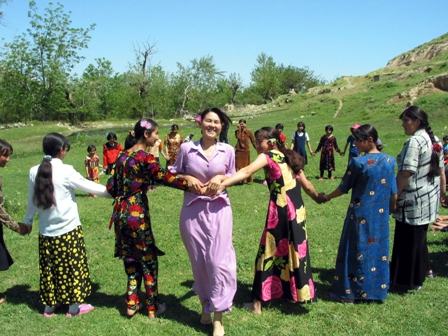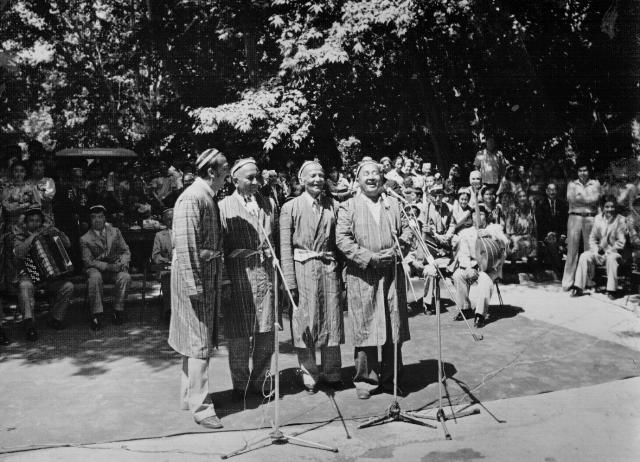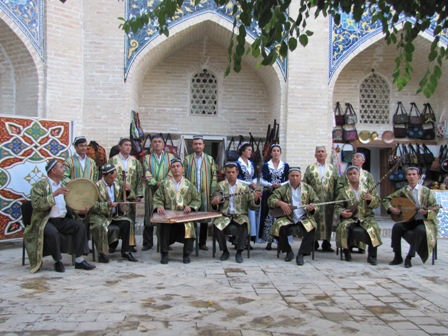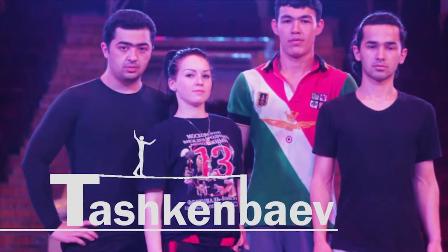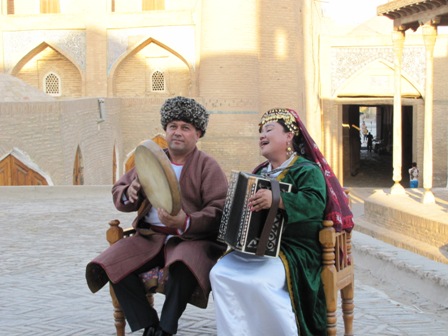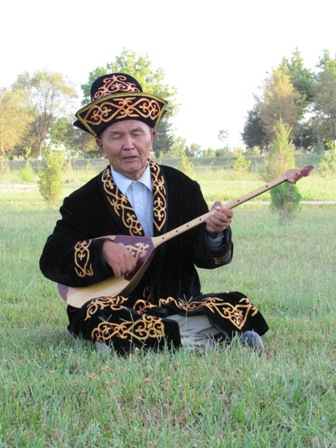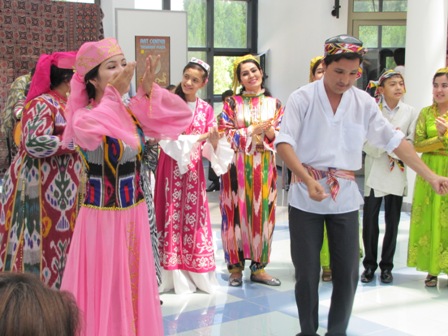Katta Ashula
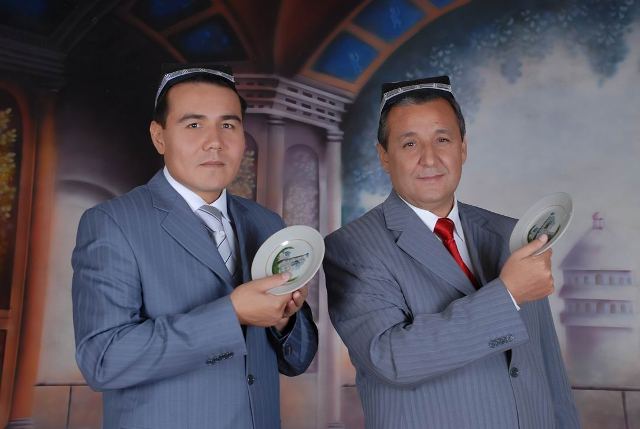
Katta ashula or Patnis ashula (literally "great song", "lofty song" or "tray song") is a vocal direction, a song genre typical for the Ferghana Valley, in which peculiar style and manner of singing is observed. It is performed by two or more (up to five) singers in turns and without accompaniment of musical instruments.
Typical for katta ashula are the following: verbal transfer of relevant knowledge and skills; existence of local peculiarities as well as improvisation techniques; professional manner of singing; rhythmically independent singing with a deep (wide) breath; existence of khamnafaslik (companionship). In katta ashula, which has in a variety of forms and manifestations, it is possible to observe somewhat distinct musical and poetical language and manner of singing. The songs in this genre are usually sung by professionally trained folk singers (called "hofiz", "kata ashulachi" or "qori"), who possess strong and high-pitched voice of a wide range and excellent improvisatory skills. Singing of katta ashula also requires excellent skills and virtuosity, undergoing a special training based on "ustoz-shogird" ("master-apprentice") methodology.
Katta ashula is a traditional singing art, which largely existed in the past and became widespread among population. To date, oral transfer of singing skills and techniques from master to apprentice remains the main method of preserving katta ashula and its spiritual values. In addition, katta ashula is characterized by laconism (in means of expression), expressiveness (in music language), dynamism (in melodic development) and bright emotionality. Its figurative structure (or style) is closely connected to the traditional (classical) poetry of lyrical and philosophical nature. And ghazals of Navoi, Lutfi, Mashrab, Khazini, Muqimi, Furqat, Zavqi, Miskin serve as main poetic texts in this genre. Though, since the XX century the poems of contemporary Uzbek poets (such as Sobir Abdulla, Charkhi, Chusti, Akmal Polat, Khabibi, and others) as well as examples of folk poetry have been widely used.
In terms of subject matter katta ashula songs can be divided into love-lyrical, didactic, religious and contemporary ones. The origins of katta ashula genre should be looked for in ancient folk-ritual chants, songs of "praise" (such as marsiya, navkha, ayolgu), agriculture- and labor-related songs with their original combination of recitative-declamatory beginning and chanting; and in distiches of ghazals (ghazalkhonlik), written in aruz prosody. And it is exactly loftiness, observed in the content of the poems used, the manner of singing in high registers, and performance in front of large auditorium during big events (such as festivities, folk promenades and wedding ceremonies) which predetermined the name of this type of song as "katta ashula". Performance with high-pitched voice, existence of culmination parts, clarity of words for and their impact to the listeners – all these are features of this type of song.
Among the people other names of katta ashula became widespread as well. These were "ashulai kalon", "katta yalla", "haqqoniy ashula", "patnis ashula" or "patnisaki ashula", "likobcha ashula". It bears mentioning that katta ashula was named as "patnisaki ashula" or "likobcha ashula" because during performance the singers usually hold in their hands a small metal tray or plate, with a help of which they regulate the direction of the sound (towards listeners, or towards themselves; it allows listening own voice and the voice of companion) and create a certain sound timbre.
Conditions, under which katta ashula existed in the XX century, and development of performance culture, in general, promoted emergence of different versions of this genre. These were: "Ananaviy" - singing by two singers independently and without accompaniment (examples include: "Bir kelsun", "Oh kim", "Ey dilbari jonon"); "Yovvoi maqom" - performance of some specific shubas of maqoms (such as "Yovvoi Ushshoq", "Yovvoi Chorgoh" and "Patnusaki Segoh") in rhythmically independent manner; "Yovvoi ashula" – singing popular vocal pieces in ashula genre in rhythmically independent manner (examples include: "Yovvoyi tanovar", "Yovvoyi munojot"); "Yakkakhonlik" – a vocal-instrumental type of katta ashula in the form of solo performance, which is accompanied by instrumental music; instrumental ensemble performs the role of the second singer (examples include: "Oh kim", "Gulizorim qani", "Yolghiz", "Topmadim"); "Cholghu yoli" – an instrumental version of popular katta ashula songs suitable for solo performance on nay, surnay, ghidjak (for example, Yovvoyi Chorgoh).
It bears mentioning that in the XX century, along with men-singers, katta ashula songs were performed by women (for example, they were performed by Khalima Nosirova, Fotima Borukhova, Zaynab Polvonova, and others).
Bearers of katta ashula traditions are both folk and professional singers, who mastered relevant knowledge and skills, peculiar singing techniques based on "ustoz-shogird" ("master-apprentice") traditional learning methodology in Kokand, Andijan, Ferghana and Tashkent; in conservatoires, colleges of art and academic lyceums named after R. Glier and V. Uspenskiy.
Notably, the emergence and development of katta ashula genre is closely linked with existence of corresponding performance schools, which stand out with their style of interpretation, manner of singing and bearers. From among katta ashula performance schools it is possible to mention Kokand performance school (Erka qori Karimov, Sherqozi Boyqoziev, Hamroqul qori, Meliqozi Yusupov, Turdiali Ergashev, Rasulqori Mamadaliev), Margilan performance school (Mamadbuva Sattorov, Boltaboy Rajabov, Jorakhon Sultonov, Mamurjon Uzoqov, "Chorgoh" group under leadership of Turdiali Sharipov), Andijan performance school (Fatohhon Mamadaliev, Odiljon Yusupov, Saidnabi Saidnazarov, Jurakhon Yusupov, Ergashvoy Yusupov, Hurshid Khasanov), Namangan performance school (Mallaboy Hamidov, Abdulla Ghoziev, Ibragim Isoqov) and Tashkent performance school (Akbar qori Khaydarov, Eshmat Khaydarov, Ochilkhon Otakhonov, Orif Alimakhsumov, Mahmud Tojiboev, Munojot Yolchieva, Beknazar Dostmurodov, Abdunabi Ibragimov, Soibjon Niyozov, Dilnura Qodirqulova, Nodira Pirmatova).
Nowadays katta ashula traditions are preserved and popularized thanks to scientific (research) and practical measures undertaken by numerous governmental and public organizations. These organizations organize expeditions, carry out scientific researches, publish books and collections, produce audio and video disks, create films and TV programmes, conduct competitions (review competitions among young singers in order to attract attention to katta ashula genre), etc.
Singers of katta ashula (or katta ashulachi) have so far participated in the VII International Music Congress (Moscow, 1971), IV Asia Musical Platform (the Philippines, 1976), European Folklore Festival (1985), US Festival of Music Folklore (USA, 1987), "Sharq taronalari" International Music Festival (Samarkand, 1997-2015), "Asrlar sadosi" Festival of Traditional Culture (Uzbekistan, 2008-2013), etc. Also, they became regular participants in nationwide holidays, such as Navruz and Mustaqillik (Independence Day). Since 1984 a republican-level competition among performers of katta ashula has been conducted (in 2013 it was organized in Tashkent region). Furthermore, the programme of the Republic of Uzbekistan, "Protection, preservation and popularization of Katta Ashula of the Ferghana Valley", was awarded with a prize (gold medal and diploma) of the Asia/Pacific Cultural Center for UNESCO (ACCU, Japan) as the best practice in protection of ICH. And in 2009, katta ashula was inscribed on the UNESCO Representative List of Intangible Cultural Heritage of Humanity.





